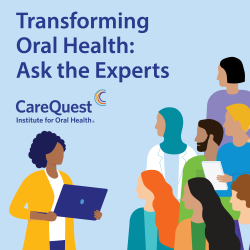Enter your email to receive the CareQuest newsletter:
August 26, 2024
By Caroline McLeod, MS, RDH, Value-Based Solutions Manager at CareQuest Institute, and Andrea Clark, MS, Director, Health Care Economics at CareQuest Institute
al·ter·na·tive: of one or more things available as another possibility.
Reusable water bottles as an alternative to single-use plastic bottles. Oat milk as an alternative to dairy milk. An electric toothbrush as an alternative to a manual toothbrush.

When trying new things, there are always growing pains. The same is true in oral health, as many health centers and organizations are navigating their way through new payment and care models that are better for patients and, ultimately, better for providers. When looking at how oral health care is typically paid for, many providers use the fee-for-service payment model, which pays a provider for each service given to an individual. This volume-based model incentivizes:
- A high volume of expensive, invasive services
- Treating symptoms and restoring health rather than preventing disease
- No tracking of health outcomes after providing care

For example, provider reimbursement for dental implants or dentures is higher than periodontal and nutritional services to prevent tooth loss. This focus on volume-based payment has resulted in increased health care spending and worsening health outcomes.
With increasing care costs and chronic disease prevalence, over the last decade the health care industry has been embracing an alternative approach to paying for services known as alternative payment models (APMs).

APMs take what we know about the fee-for-service model and improve upon its known challenges to:
- Link financial incentives to improvements in care quality and health outcomes
- Focus on disease management and prevention to lower spending
- Pay for comprehensive and coordinated services
The Centers for Medicare and Medicaid Services operationalizes APMs across the nation. The design of each model follows a framework created by the Health Care Payment Learning and Action Network. The framework showcases how APMs can take a variety of forms: giving performance bonuses to reward providers for quality care, for example, or capitation, which is an upfront payment to a provider to coordinate comprehensive, multidisciplinary care.
So, what do APMs look like in dentistry?
- From 2016–2021, California Medicaid tested bundled payments of $126 per pediatric patient for completion of caries risk assessment, nutritional counseling, and motivational interviewing. The provider-designated patient risk level informed the frequency of covered preventive care, where individuals with a higher risk for caries (cavities) received more frequent coverage for preventive services.
- Since 2017, Texas Medicaid has operated a capitation-based model with dental plans to hold dental providers accountable for performance on quality measures of oral evaluations, topical fluoride, sealants, emergency department visits, and care continuity for children.
When one option may not work for current circumstances, trying something different creates space for discovery, growth, and new perspectives on success. As the health care industry tests APMs, it is constantly learning how to better set providers up for success, improve practice infrastructure for participation, and ensure models address health equity and do not perpetuate health disparities.
CareQuest Institute is committed to understanding how oral health best fits into the changing health care payment landscape. Are you testing an oral health APM? Let us know here. Interested in learning more about APMs? Check out our resources below.
- Unlocking Value in Alternative Payment Models
- Update on Alternative Payment Models in Oral Health Care
- Alternative Payment Models in Dentistry
- An Introduction to Value-Based Care in Oral Health: Moving from Volume to Value
Caroline McLeod, RDH, MS, is a published thought leader and researcher of alternative payment models. As a dental hygienist, she is passionate about unifying oral health and overall health, facilitated by reimbursement models that empower providers, improve health outcomes, and bolster health equity. Andrea Clark, MS, is a health care economist and data scientist with more than 25 years of experience informing strategy and overseeing efforts to enable value-based care in the Medicaid and oral health spaces.